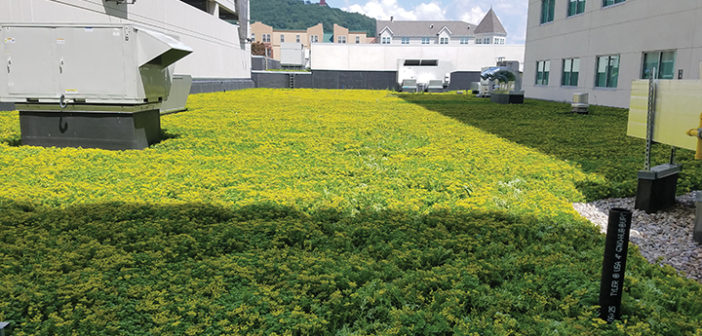NATIONAL REPORT—Hotel green roofs have been popping up for a while now. While green roofs have many benefits, mainly environmental, drawbacks aren’t frequently discussed. But one potential downside of having a green roof—pests.
“Green roofs can be wonderful assets to hotels,” said Molly Meyer, CEO of Chicago, IL-based Omni Ecosystems. “Hotels are improving the views outside of rooms that overlook roofs by adding greenery. What is otherwise an undesirable view can be turned into a requested one. Plus, green roofs help the environment—by creating a habitat, by managing stormwater, by decreasing the temperature of the roof and the surrounding air, among other benefits.”
Eric Brown, GM of Reading, PA-based DoubleTree by Hilton Hotel Reading, which has a vegetative roof covering approximately 32,000 sq. ft. of roof space, enumerated many of the same advantages: reduction in energy costs, particularly by lessening the load during warm months; improved air quality; and increased green space in urban environments. Children from Reading Recreation planted the plants on the property’s expansive green roof, and Hope Rescue Mission volunteers made the planter boxes.
Situated in Toronto, AccorHotels’ Fairmont Royal York’s rooftop garden is home to six beehives, where approximately 350,000 honeybees live—all of which will assist the property with harvesting about 900 lbs of honey this year. “Our honeybees also assist in pollinating our herbs and vegetables found on the rooftop garden for ingredients that become part of Epic Dining Room’s recipes on its menu,” said Fairmont Royal York Executive Chef Robert Mills. “Right next to the honeybees is the bee hotel, which is an inviting suite for many species’ solitary bees.”
Green roof planning more often than not takes longer than the installation itself, due to several reasons. “The planning phases usually take at least a couple of months,” Meyer said. “Planning first includes a structural analysis, assessment of the roof membrane and, in some cases, installation of a new roof membrane. Once the roofing and structural assessments are complete, then the planting design and logistical planning can begin. The duration of the installation depends on the complexity and size of the green roof. On average, installations last between one week and one month.”
As with any garden, unwanted guests can become an issue if they’re not dealt with in a timely manner, but being high up to begin with oftentimes restricts possible infestations. “Fortunately, many pests aren’t a concern on green roofs because they cannot get there,” Meyer said, pointing out how green roofs don’t have issues with deer or rabbits, for example. “Pests depend on your region and what plants you’re growing. On a farm roof in Chicago, you may see aphids. On a freshly seeded roof in Indianapolis, you may see geese.”
“To protect our garden, I planted nasturtiums and marigolds to keep undesirable pests from eating such things as the tomatoes and strawberries,” Mills said. “The small size of the alpine strawberries helps keep birds away as they are hidden under the leaves. The only small issue we have now is ants, but they don’t seem to cause any trouble to either the plants or the beehives. The best way for us to ensure we don’t have any bug issues is to make sure the plants that we bring in every year don’t bring guests with them.”
Other properties haven’t been too concerned with controlling pests. For instance, DoubleTree by Hilton Hotel Reading isn’t currently doing pest control, “as [the roof]is a relatively new feature for the hotel, and we have not had any problems with roaches, ants, flies or rodents,” Brown said, noting the only potential pest issue they’ve noticed to date is birds dropping wildflower seeds on the roof, thereby attracting bumblebees to the area. “However, this has not been an outstanding issue of concern to the property and, therefore, pest control is not needed.”
It’s natural for properties with green roofs to have pest issues. “Green roofs are a form of living architecture, so as soon as you start planting, pests will begin arriving,” said Chelle Hartzer, an entomologist and a technical services manager at Atlanta-based Orkin LLC, a pest control services company.
Some of the most common pests found on hotel green roofs are rodents, birds, mosquitoes, flies (house flies and fruit flies), stinging insects, ants and cockroaches. Preventing pest activity can be as simple as paying attention to the green roof and recognizing any potential issues ahead of time. Trained employees are the first line of defense. “If your whole staff knows how to respond to pest sightings or potential pest hot spots, you can catch many issues before they become true problems,” she said, adding that many pest management professionals will more often than not offer a free training for employees. “Schedule those regularly for new and existing employees to make sure they know where to look, what to look for and who to report sightings to.”
Giving the green roof some extra attention can go a long way. “Regularly trim and prune plants in, around and on the building,” she explained. “Not only does this help beautify your property, it also eliminates overgrowth that pests will use as good hiding spots.”
Stopping mosquitoes from laying eggs requires a property’s water features to be circulating regularly. “Check HVAC units to ensure the filters are functioning and properly installed,” Hartzer said. “Make sure there is proper drainage for any water condensing off these units.” Additionally, monitor excessive water accumulation from leaky taps and irrigation. If anything is of concern, be sure to eliminate it immediately.
Trash bins should be covered at all times (with tight-fitting lids) and emptied regularly. All cracks, holes and other entry points in the exterior should be sealed with water-resistant sealant and metal mesh. “Be sure to caulk around all utility connections and outlets as well,” she said. Keep doors shut to prevent pests from entering the building.
Pay specific attention to the plants being grown in the gardens. “One thing hoteliers can forget is that plants that produce nuts, fruit or seeds can become a quick source of food for insects, rodents and birds,” Hartzer said. “Instead, choose evergreen bushes or non-fruit-bearing trees that will not grow too tall and are easy to maintain.”
There are products to consider as well. For example, having moisture meters in plant beds can help prevent overwatering. “This helps limit the water accumulation that attracts pests,” Hartzer said. Another product to have readily available on a green roof is a quality flashlight, which will assist employees with searching for pests in dark areas.
Avoid using heavy mulch in planters to “avoid creating the perfect shelter for cockroaches and other pests,” she explained. There are alternatives to relying solely on organic mulch for green roofs: cedar mulch is one option, rubber mulch is another.
“Just like your home garden, if you keep your green roof clean, neat and well taken care of, you can provide a beautiful guest experience without pest problems,” Hartzer said. HB


